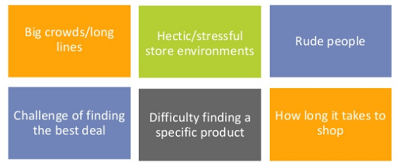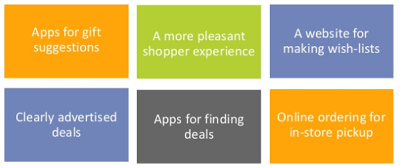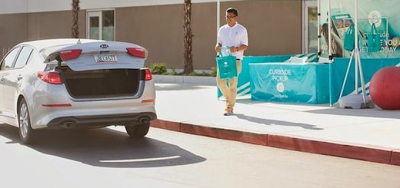
Shoppers have an idealized vision of holiday shopping. Unfortunately, they are too often met with a reality of crowded stores, out-of-stock merchandise and rude employees. Fear not: Improving the customer experience is possible if you use these 12 research-generated solutions.
As we noted in a previous post on back-to-school shopping, consumers view holiday shopping as a special experience. They envision a family outing, strolling through stores decked out with festive lights, holiday cheer and smiling faces all around.
Our Digsite qualitative research indicates those hopes are quickly dashed when the experience turns negative. While we learned the big turn-offs for consumers, our research also encouraged participants to brainstorm solutions for those holiday shopping problems.
Their ideas weren’t ground-breaking in themselves, but they give you a fuller understanding of the nature of the problem. We used them to generate 12 solutions to improve the customer experience.
Consumers Want Technology to Help Improve the Shopping Experience
Shopping has become a mash-up of multiple online devices. Smartphones, tablets and desktop computers all play a role in in-store and online shopping. Consumers want retailers to use these devices to help improve the process.
-
63% of holiday shoppers wanted help checking out of the store more quickly. Source: National Retail Federation
-
53% of mobile app users are looking for major improvements in the app (they actually prefer the website to the mobile app). Source: United Problem Solvers
-
22% of shoppers want retailers to know more about how they shop online so the shopping experience can be improved. Source: Chainstoreage.com
But what are the pain points that technology needs to solve?
We used a Digsite “Brainstorming” Sprint to find out. A Digsite Sprint is an on-demand market research study designed to provide in-depth insights from a targeted audience. The interactive interface allows participants to answer questions, share ideas and images, and respond to each other’s comments.
We asked an online community of 25 participants, each of which spent at least $700 on holiday shopping, what their pain points included. Here are the top six:

We then asked them what would make holiday shopping better. Here were their main “pleasure” points:

We then asked them to submit ideas on how to improve the shopping experience. All their solutions revolved around using technology to help manage their holiday lists and find deals easily. They voted on the solutions, and three winning ideas emerged.
-
Create an app to help shoppers find the best deal
-
Create an app to help customers locate gifts and check store inventories
-
Create an app to organize shopping lists and purchases
You can download the full report to learn more about the three ideas.
Building on Their Solutions: Ideas for Improving the Shopping Experience
If you’re a marketer or a retailer, how do you build on both the pain points and the ideas of the holiday shopper? Essentially, the big takeaways from our research indicated the following areas are key for marketers and retailers:
Address crowds and lines: Less cluttered stores and no waiting for checkout
-
Reduce negative interpersonal interactions: Improve behavior of employees and fellow shoppers
-
Guide shoppers through the process: More helpful apps and organized store layouts
-
Help with gift suggestions and selections: Generate ideas and gift-list sharing
-
Find and manage deals: Provide apps to aggregate different store offerings
To meet these challenges, here are 12 solutions.
1. Eliminate lines altogether
One Digsite participant suggested hiring more holiday help to reduce or eliminate long lines. Walmart (@walmart) seems to have heard this one loud and clear. Fortune Magazine (@fortunemagazine) reported Walmart was cutting some 7,000 accounting and invoicing positions within US stores to have more workers on the floor, improving in-store customer service. You might want to follow suit with your own store.
2. Offer curbside pickup
Target experimented with curbside pickup, but abandoned it to focus on enhancing its “digital-store offerings,” as reported by Consumerist @consumerist.
Curbside pickup seems counter-intuitive to retailers, as it restricts the impulse buys of consumers. But if you’re providing a preferred delivery option, it should be a strong consideration. Retail Dive (@retaildive) takes a deeper dive into how to do curbside pickup right.

Photo courtesy of RetailDive
3. “Walk the line” with a modern point-of-sale system
Any visit to an Apple store will reveal the benefits of a cloud-based, mobile point-of-sale system. Francesca Nicasio (@francescaSN) of VendHQ (@vendhq) reported how Internet-based Medisave sold stethoscopes at a tradeshow, walking back through the lines during crowded times to make the sale. Get out from behind the cash register and check out those customers!
4. Amazon’s bold new brick-and-mortar vision
RetailWire (@retailwire) reported that Amazon apparently has a patent that used radio-frequency identification (RFID) technology and video cameras to eliminate the checkout process altogether. A customer walks in, picks out an item, and then walks out. The video camera recognizes the person and bills their account automatically. Wow.
.png?width=448&name=Digsite%20PullQuote%20-%20HldyStySolutns%20(1).png)
5. Apply analytics and use the Internet of Everything
An article in Chain Store Age (@chainstoreage) describes how lighting up the “dark assets” in a store -- shelf sensors, video cameras, beacons -- and applying advanced analytics will help retailers respond to increased customer surges, thus staffing registers appropriately.
6. Make your employees happy first
The Retail Doctor Bob Phibbs (@theretaildoctor) notes that “satisfied employees make for satisfied customers.” Make sure they’re well-trained, informed, and happy with their jobs. These happy staffers also need to engage customers right from the get-go; apathy is not a favorable holiday behavior.
7. Make sure your store is organized and well-laid out
We noted in our last study on back-to-school shopping that how a store is organized is important to shoppers. Make sure your merchandise is neat and items are easy to find. Refer to our previous research in this area -- it applies to holiday shopping as well.
8. Feed ‘em
A hungry shopper is a cranky shopper. Lighten the mood by partnering with a restaurant or a grocery store and put some food out for your guests. In her LinkedIn post, Vicky Applebaum (@vickyapplebaum) explains that HEB, a retail store in Texas, offers extensive in-store samples.
“Through their sampling program (including plenty of wine samples), they are serving the customer’s need for Discovery, a reason to explore beyond what’s on their shopping list and simply enjoy the experience of shopping,” Applebaum writes.
9. Give loyal customers the store to themselves
One customer in the Digsite study thought it would be great to have the store to themselves as part of a loyalty program. While that might not be entirely practical, reserving certain hours for your loyalty members sounds like a fantastic idea.
Help Scout (@helpscout) refers to this as a “hosting an in-store event after hours.” Because holiday shoppers do their planning well in advance, you can likely find time well before the really busy holiday shopping season kicks in.
10. Help them find what they want
One of the ideas generated by the Digsite was to create “an app to help customers locate gifts and check store inventories.”
Meet Aisle411 (@aisle411), an “indoor location service platform” that utilizes scalable indoor mapping, navigation and analytics tools. It helps stores optimize their floorplan and lets consumers find what they want, quickly and efficiently. Check out the video below to see it in action.
11. Let them keep track of their gifts
Another idea was to organize and keep track of all the gifts. Did you get the tie for Dad and the football for nephew Billy? Gifster (@MyGifster) is a wish-list registry website / app. You can share gift lists with family and friends -- including links to product websites. Check out their video.
12. Make it easy for customers to find the best deal
There are countless apps and websites like BuyVia (@buyvia) that alert customers to best deals. What’s notable about BuyVia is that they “professionally curate” the deals, so users don’t have to rummage through all the prices.
Notice anything about these holiday shopping solutions? Like they can be applied at times other than the holidays?
That’s right. While these ideas and the Digsite brainstorming that customers did was related to holiday shopping, the nature of their comments can be applied to any season, online and off.
Co-creating ideas and solutions with your customers in an online community like Digsite provides you with a golden path toward improving the customer experience, and even innovate in the process.
It’s no longer enough to find out what’s wrong with a shopping experience. Now you can use research to create what’s right. And that’s a gift for both retailers and consumers.




